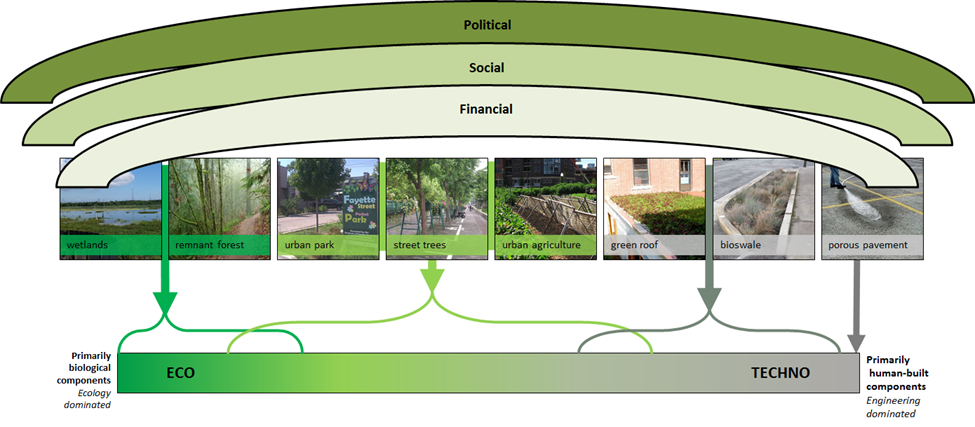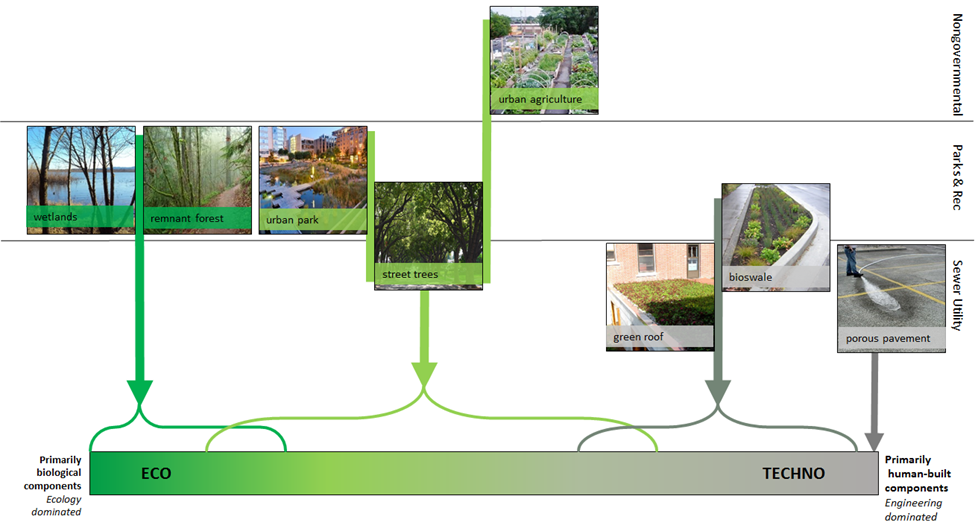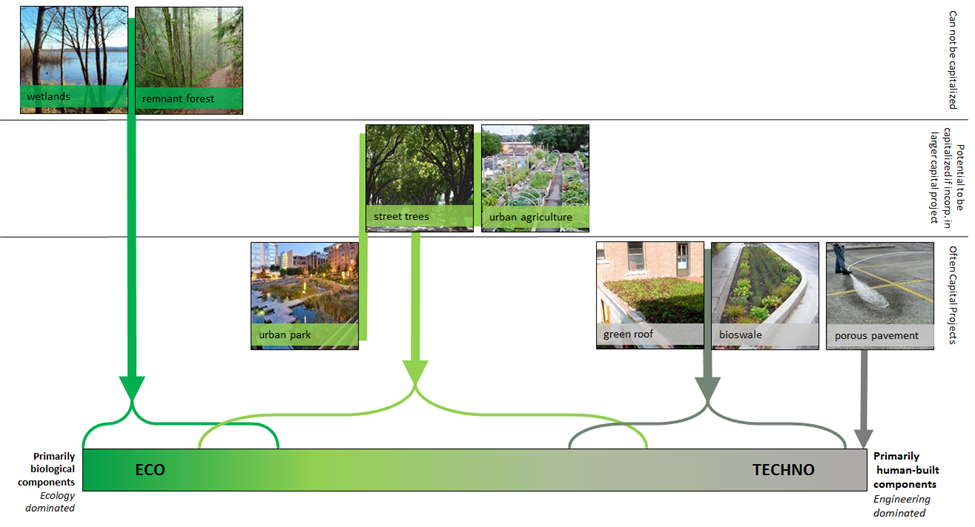Green Infrastructure for a Resilient Urban Future
Green infrastructure (GI) is an increasingly popular climate change adaptation solution in cities today. As a broad concept that entails using and mimicking nature and ecology to provide services in cities, the concept of GI presents an alternative to traditional development by centering nature and ecology in the design, implementation, and management of urban areas. This centering shows promise in increasing the resilience of cities in the face of climate change.
Currently, “green infrastructure” is a term that means different things to different people. GI includes both natural and human-made features. Just as a transportation system and utility system plays critical roles in infrastructure building of cities, the GI system is a fundamental infrastructure system to keep the city healthy, sustainable, and resilient. Open space and parks, natural preserves, city parks and recreation, urban plazas, streetscapes, individual yards, etc. all are part of the green infrastructure that provide multifunctional ecosystem services.
GI has most popularly been deployed as a stormwater management tool. The US EPA encourages GI as a low-cost, multifunctional solution to improve water quality and manage stormwater discharge volume. Many municipalities have adopted this definition for green infrastructure. As stated in Section 502 of the Clean Water Act, this form of GI is “…the range of measures that use plant or soil systems, permeable pavement or other permeable surfaces or substrates, stormwater harvest and reuse, or landscaping to store, infiltrate, or evapotranspirate stormwater and reduce flows to sewer systems or to surface waters.”
Alternative GI definitions, however, broaden the conception of GI to include a wide range of facilities and scales. Childers et al. (2019) define “urban ecological infrastructure” – or UEI – as a response to what many have viewed as myopic conceptions of ecologically important features in urban areas. In the authors’ own words, “UEI encompasses all parts of a city that include ecological structures and functions. Ecological structure is the physical components that make up ecosystems (e.g. species, soils, waterways) while ecological function is the processes that result from interactions among the structural components (e.g. primary production, nutrient cycling, decomposition).” In their paper, the authors make clear that it is ecological and structure and function that make urban components ecological, not simply that they consist in part or completely of “natural”, and typically green, components. That is, cement planters are ecological infrastructure because they are sites of ecological structure and function derived from the plants they contain; they should not be excluded from accountings of important ecological infrastructure because they are in part synthetic cement structures. Further, the authors argue for the rigorous consideration and accounting of other “colors” (i.e. forms) of infrastructure, on the grounds that they also provide critical ecological structure and function. “Blue” aquatic features such as ponds provide nutrient cycling functions and habitat structures; “turquoise” hybrid features like wetlands do the same; “brown” features like vacant lots and bare soil contribute biogeochemical cycling and water infiltration. The Childers et al. definition of UEI probably represents the widest net that urban ecologists can cast when examining important urban ecological infrastructure, but we find the justifications to be sound and many of us in this task force recognize it as the closest representative in the literature to our own conceptions of urban ecological infrastructure.
These differing definitions reflect the heterogeneity of GI conceptions across the cities in the UREx network and the diversity of research approaches our members bring to the topic. Through these different approaches, we have sought to bring together Social (S), Ecological (E), and Technological (T) dimensions of GI using a unified SETS framework. One attempt to do so is displayed in Figures 1, 2, and 3. Figure 1 displays the range of facility types found in GI conceptions across the UREx SRN cities. These facilities are organized as a spectrum by the proportion of each that is biological, representing an actual ecological structure and function. This is the “eco” side of the spectrum. On the “techno” side of the spectrum, facilities consist primarily or completely of human-made technological components that mimic ecological functions. As shown in Figure 1, this spectrum provides a platform to examine social, political, and financial systems (as displayed in Figures 2 & 3) because it spans all the various jurisdictions and actors that interact with GI.
In sum, GI is often considered a “win-win” policy strategy: it has the potential to reduce flooding from storm events, mitigate extreme heat, decrease the amount of energy and resources necessary to address these problems, while also providing aesthetic values and sense of place to human communities. However, examining GI as complete SETS can point to the shortcomings of different facility types in providing the full range of co-benefits.



Green infrastructure across the UREx Network
Green infrastructure is of interest to many different researchers in the UREx project and we have approached the study of green infrastructure from many disciplines, including engineering, governance, ecology, policy, hydrology, and economics.
What have we found?
The story of green infrastructure differs in each of our network cities. For example, a dominant conception of green infrastructure is its use as a stormwater management tool. In NYC, Syracuse, Portland, and Baltimore green infrastructure programs consist primarily of the construction of engineered facilities (rain garden and green roof construction is popular). In contrast, flooding from monsoon events is a major challenge faced in Phoenix and Hermosillo where large bioretention ponds are common green infrastructure facilities. As coastal cities, Miami and NYC are concerned with flooding from storm surge and extreme rainfall, leading to the prominence of dunes, vegetated land, and wetlands. In San Juan and Valdivia, green infrastructure efforts have focused on conserving existing greenspace. We found unique considerations for green infrastructure purpose and performance across contexts, along with similarities in planning challenges across our network cities.
GI has been investigated from a number of perspectives across the different contexts described above. Highlights from this UREx work are listed below:
Workshops & Engagement:
- GI Virtual Innovation Plazas
- From Nov 2018 to March 2019, three online dialogues focused on practitioner experiences of successful green infrastructure implementation stories from Portland (Oregon), Bogotá (Colombia), and Phoenix (Arizona).
- GI workshop in Baltimore:
- On 18 April 2019, a workshop on Pathways to Green Infrastructure Implementation was held to identify design principles and best practices for working with communities on GI implementation, including a special presentation from Blue Water Baltimore’s Ashley Traut on how to put people first in the planning process.
- Graduate and postdoctoral fellows have produced several episodes of the Future Cities podcast about various diverse forms of green infrastructure and the impacts of that GI. Below are those episodes:
Academic publications:
- Financing green infrastructure is difficult. As a new and yet-to-be-standardized form of infrastructure, many different sources are often cobbled together to fund emerging green infrastructure programs in the United States. A recent review of an ASLA project database of green infrastructure projects summarizes current strategies in place (Zimmerman, Brenner, and Llopis Abella 2019).
- Green infrastructure has evolved over more than a century, co-exists with other forms of infrastructure, such as gray infrastructures, and can be integrated with these other forms (Zimmerman, Grimm, and Brawley-Chesworth 2020).
- Most existing green infrastructure is designed to accommodate average events, not extreme events. Research looking at design storms used to size green stormwater infrastructure facilities (i.e. bioswales, green roofs) has shown that most cities in temperate regions design green infrastructure facilities to accommodate average rainfall and stormwater runoff events; in extreme, concentrated rainfall events – called cloudbursts – these green stormwater infrastructure facilities are quickly overwhelmed (Rosenzweig et al. 2018).
- Cities are beginning to work together to share knowledge and develop stormwater GI that provides ecosystem services between rain events, during conventional design storms, and under extreme rain conditions (Rosenzweig et al. 2019).
- The New York City Green Infrastructure Plan demonstrates how innovative, engineered systems that mimic natural water cycling processes can be utilized to improve water management in an ultra-urban setting. Although New York City has not been able to meet anticipated stormwater management milestones, the city demonstrated that green infrastructure could be successfully deployed in even its densest communities and that the use of green infrastructure can be institutionalized into city operations (Rosenzweig and Fekete, 2018).
- Green stormwater infrastructure (GSI) is more concentrated in affluent neighborhoods in Baltimore and Portland, indicating that there are distributional equity concerns in those cities. Cities may need to allocate more resources to less affluent diverse neighborhoods that do not currently have GSI (Baker et al. 2019).
- Spatial distribution of GSI matters. Distributed GSI outperformed centralized structures, reducing runoff ratio, peak discharge, and flashiness index in a suburban Portland neighborhood. The findings of this research indicate that downstream flooding could be reduced more effectively with a careful spatial design of GSI (Fahy and Chang 2019).
- Comparison of green infrastructure types and policies across contexts (McPhillips and Matsler 2018)
- Socio-ecological frameworks for stormwater management (Flynn and Davidson 2016)
- A framework called “climate justicescapes” integrates SETs vulnerability indices and spatial analysis in 48 continental US states to identify hotspots of climate justice in cities. This helps identify gaps and prioritize resources for investing in GI in vulnerable communities (Cheng 2020).
- Social microbial activity in bioswales was tested across multiple UREx cities (Rivers 2018).







